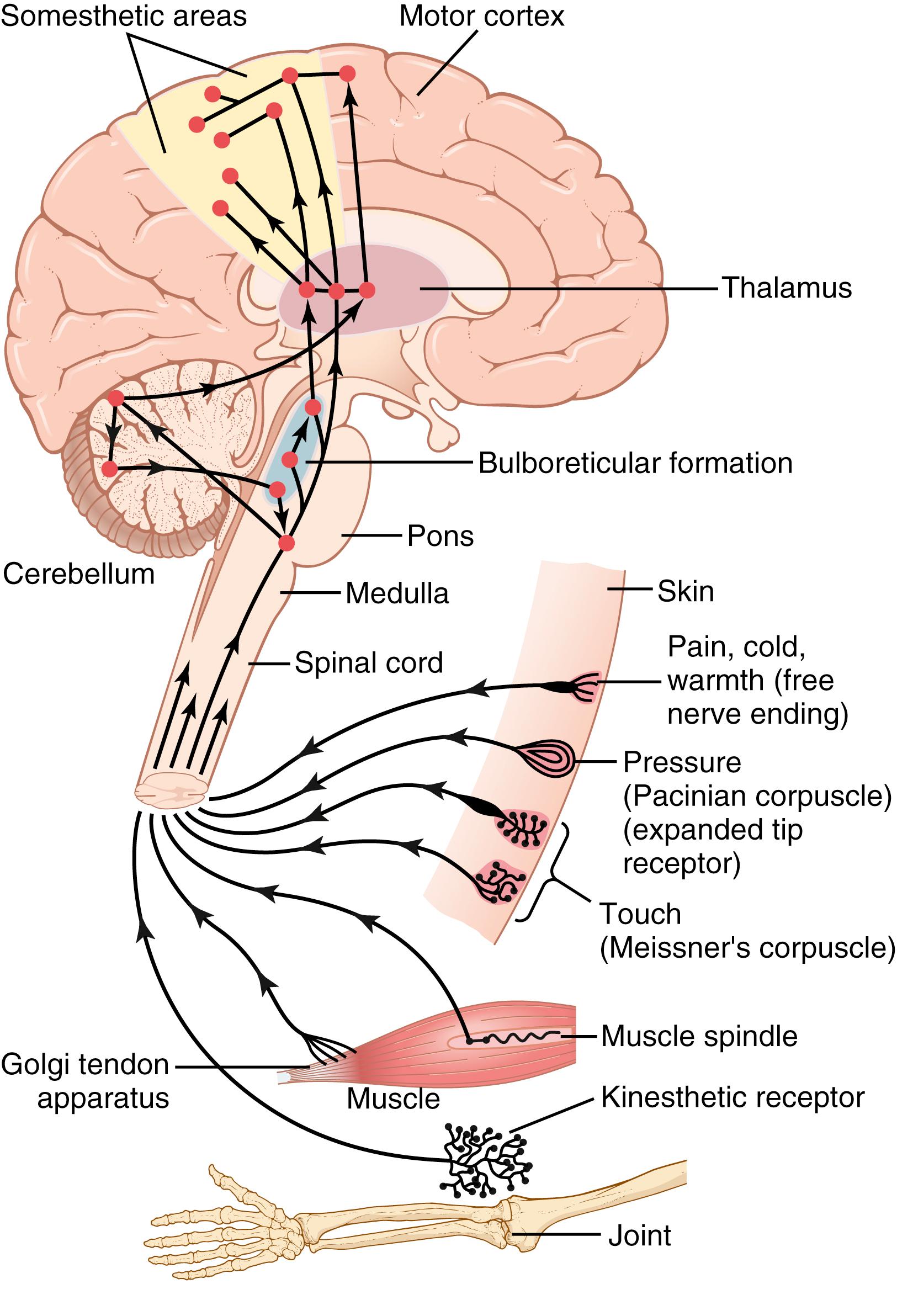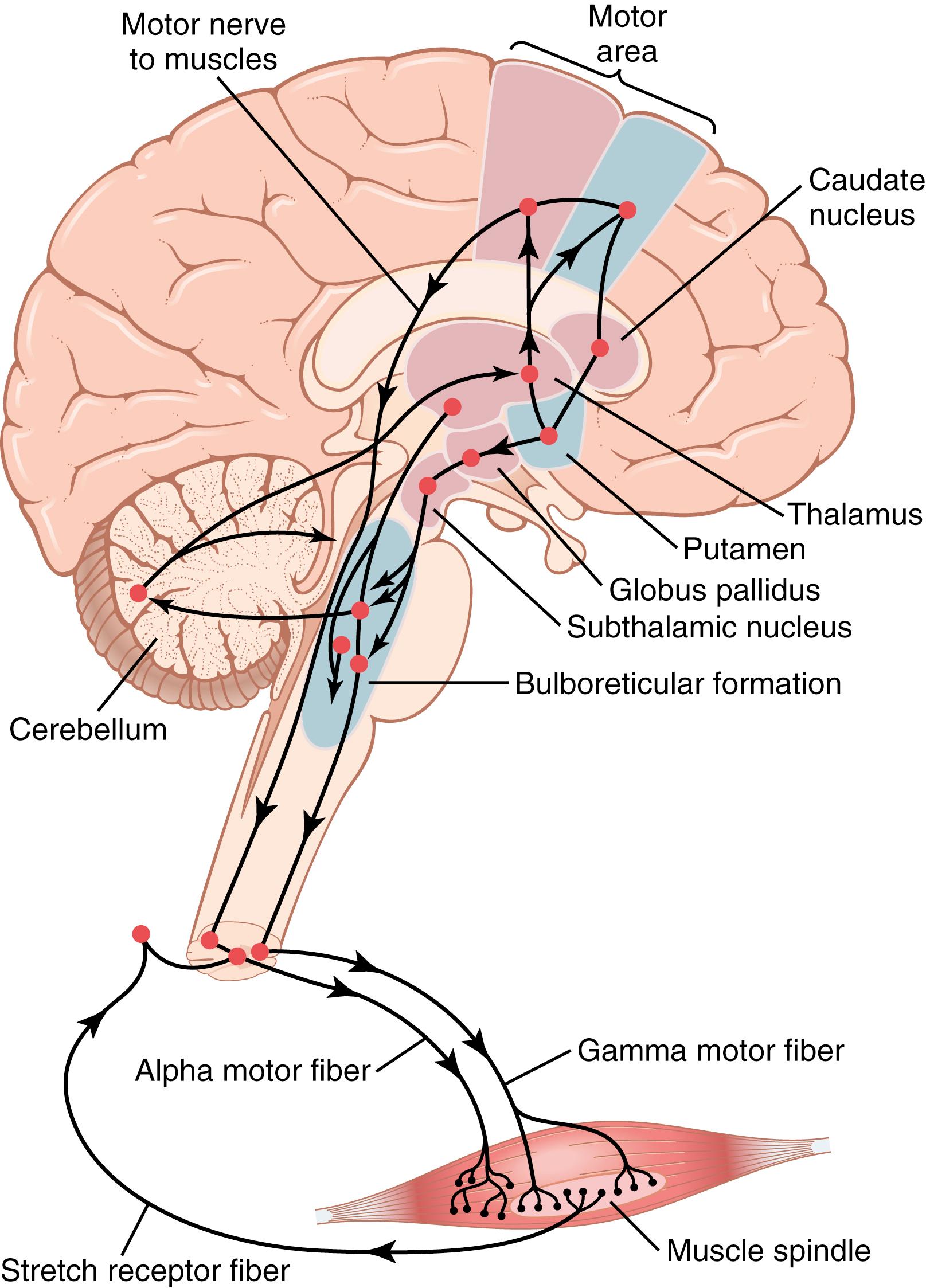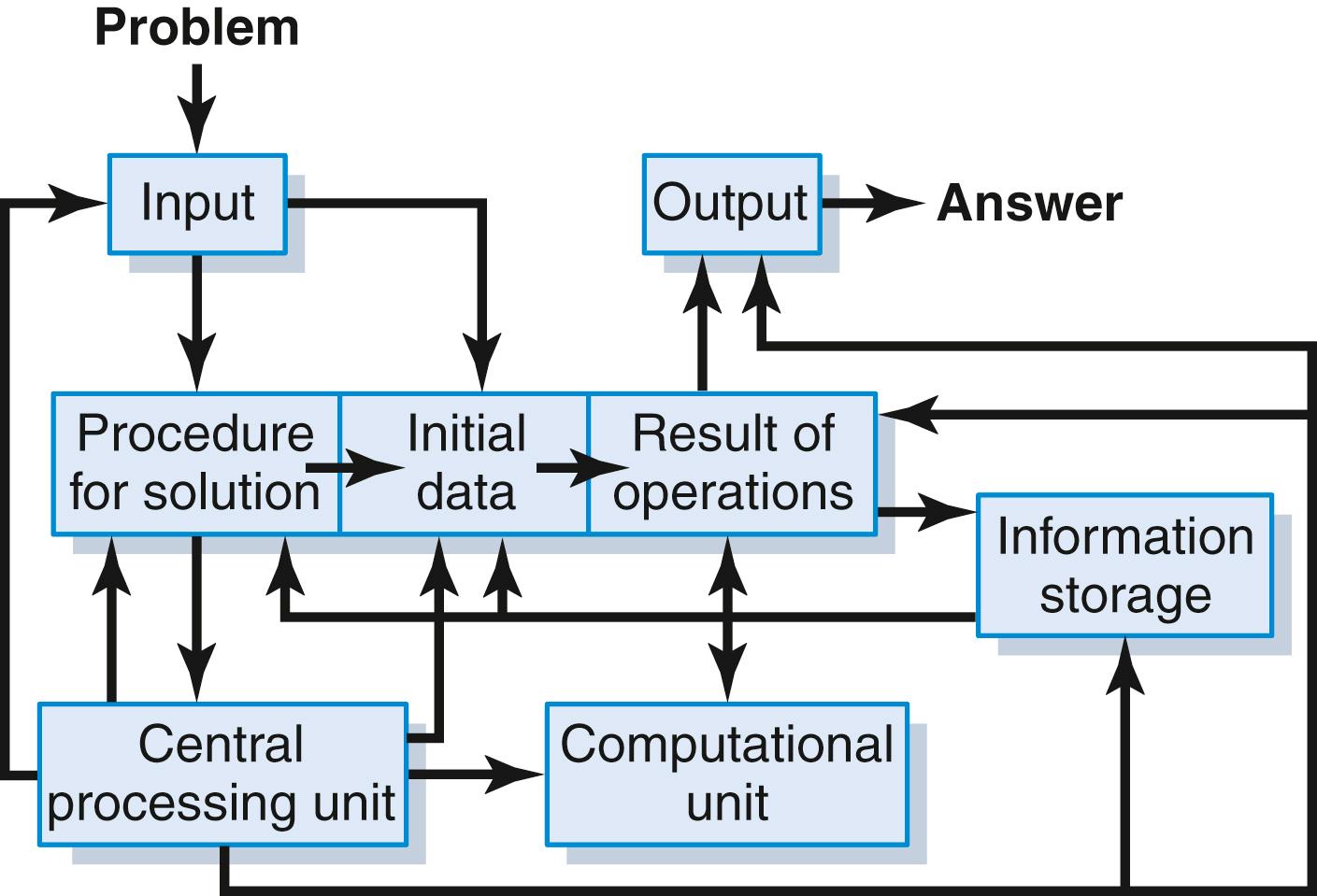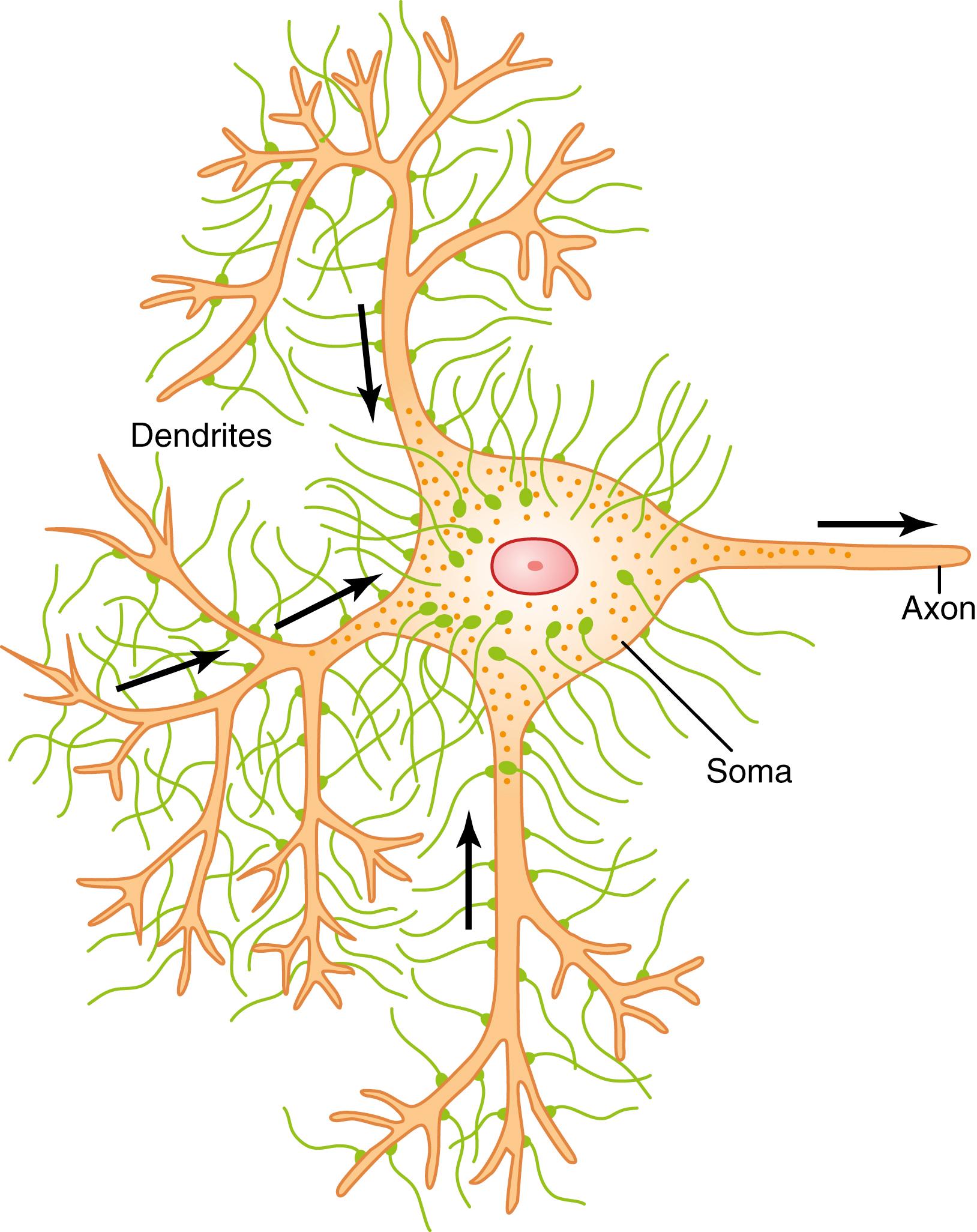Physical Address
304 North Cardinal St.
Dorchester Center, MA 02124
The nervous system is unique in the vast complexity of thought processes and control actions that it can perform. Each minute it receives literally millions of bits of information from the different sensory nerves and sensory organs and then integrates all these to determine responses to be made by the body.
Before beginning this discussion of the nervous system, the reader should review Chapter 5, Chapter 7 , which present the principles of membrane potentials and transmission of signals in nerves and through neuromuscular junctions.
The central nervous system is estimated to contain 80 to 100 billion neurons. Figure 46-1 shows a typical neuron of a type found in the brain motor cortex. Incoming signals enter this neuron through synapses located mostly on the neuronal dendrites, but also on the cell body. For different types of neurons, there may be only a few hundred or as many as 200,000 such synaptic connections from input fibers. In contrast, the output signal travels via a single axon leaving the neuron. Then, this axon may have many separate branches to other parts of the nervous system or peripheral body.

A special feature of most synapses is that the signal normally passes only in the forward direction, from the axon of a preceding neuron to dendrites on cell membranes of subsequent neurons. This feature forces the signal to travel in required directions to perform specific nervous functions.
Most activities of the nervous system are initiated by sensory experiences that excite sensory receptors , whether visual receptors in the eyes, auditory receptors in the ears, tactile receptors on the surface of the body, or other types of receptors. These sensory experiences can either cause immediate reactions from the brain, or memories of the experiences can be stored in the brain for minutes, weeks, or years and determine bodily reactions at some future date.
Figure 46-2 shows the somatic portion of the sensory system, which transmits sensory information from the receptors of the entire body surface and from some deep structures. This information enters the central nervous system through peripheral nerves and is conducted immediately to multiple sensory areas in (1) the spinal cord at all levels; (2) the reticular substance of the medulla, pons, and mesencephalon of the brain; (3) the cerebellum; (4) the thalamus; and (5) areas of the cerebral cortex.

The most important eventual role of the nervous system is to control the various bodily activities. This task is achieved by controlling (1) contraction of appropriate skeletal muscles throughout the body; (2) contraction of smooth muscle in the internal organs; and (3) secretion of active chemical substances by both exocrine and endocrine glands in many parts of the body. These activities are collectively called motor functions of the nervous system, and the muscles and glands are called effectors because they are the actual anatomical structures that perform the functions dictated by the nerve signals.
Figure 46-3 shows the “skeletal” motor nerve axis of the nervous system for controlling skeletal muscle contraction. Operating parallel to this axis is another system, called the autonomic nervous system , for controlling smooth muscles, glands, and other internal bodily systems; this system is discussed in Chapter 61 .

Note in Figure 46-3 that the skeletal muscles can be controlled from many levels of the central nervous system, including (1) the spinal cord; (2) the reticular substance of the medulla, pons, and mesencephalon; (3) the basal ganglia; (4) the cerebellum; and (5) the motor cortex. Each of these areas has its own specific role. The lower regions are concerned primarily with automatic, instantaneous muscle responses to sensory stimuli, and the higher regions are concerned with deliberate complex muscle movements controlled by thought processes of the brain.
One of the most important functions of the nervous system is to process incoming information in such a way that appropriate mental and motor responses will occur. More than 99% of all sensory information is discarded by the brain as irrelevant and unimportant. For example, one is ordinarily unaware of the parts of the body that are in contact with clothing, as well as the seat pressure when sitting. Likewise, attention is drawn only to an occasional object in one’s field of vision, and even the perpetual noise of our surroundings is usually relegated to the subconscious.
However, when important sensory information excites the mind, it is immediately channeled into proper integrative and motor regions of the brain to cause desired responses. This channeling and processing of information is called the integrative function of the nervous system. Thus, if a person places a hand on a hot stove, the desired instantaneous response is to lift the hand. Other associated responses follow, such as moving the entire body away from the stove and perhaps even shouting with pain.
The synapse is the junction point from one neuron to the next. Later in this chapter, we discuss the details of synaptic function. However, it is important to note here that synapses determine the directions that the nervous signals will spread through the nervous system. Some synapses transmit signals from one neuron to the next with ease, whereas others transmit signals only with difficulty. Also, facilitatory and inhibitory signals from other areas in the nervous system can control synaptic transmission, sometimes opening the synapses for transmission and, at other times, closing them. In addition, some postsynaptic neurons respond with large numbers of output impulses, and others respond with only a few. Thus, the synapses perform a selective action, often blocking weak signals while allowing strong signals to pass but, at other times, selecting and amplifying certain weak signals and often channeling these signals in many directions rather than in only one direction.
Only a small fraction of even the most important sensory information usually causes immediate motor response. However, much of the information is stored for future control of motor activities and for use in the thinking processes. Most storage occurs in the cerebral cortex , but even the basal regions of the brain and the spinal cord can store small amounts of information.
The storage of information is the process we call memory , which is also a function of the synapses. Each time certain types of sensory signals pass through sequences of synapses, these synapses become more capable of transmitting the same type of signal the next time, a process called facilitation. After the sensory signals have passed through the synapses a large number of times, the synapses become so facilitated that signals generated within the brain itself can also cause transmission of impulses through the same sequences of synapses, even when the sensory input is not excited. This process gives the person a perception of experiencing the original sensations, although the perceptions are only memories of the sensations.
The precise mechanisms whereby long-term facilitation of synapses occurs in the memory process are still uncertain, but what is known about this and other details of the sensory memory process are discussed in Chapter 58 .
Once memories have been stored in the nervous system, they become part of the brain processing mechanism for future “thinking.” That is, the thinking processes of the brain compare new sensory experiences with stored memories; the memories then help select the important new sensory information and channel this into appropriate memory storage areas for future use or into motor areas to cause immediate bodily responses.
The human nervous system has inherited special functional capabilities from each stage of human evolutionary development. From this heritage, three major levels of the central nervous system have specific functional characteristics: (1) the spinal cord level; (2) the lower brain or subcortical level; and (3) the higher brain or cortical level.
We often think of the spinal cord as being only a conduit for signals from the periphery of the body to the brain or in the opposite direction from the brain back to the body. This supposition is far from the truth. Even after the spinal cord has been cut in the high neck region, many highly organized spinal cord functions still occur. For example, neuronal circuits in the cord can cause (1) walking movements; (2) reflexes that withdraw portions of the body away from painful objects; (3) reflexes that stiffen the legs to support the body against gravity; and (4) reflexes that control local blood vessels, gastrointestinal movements, or urinary excretion. In fact, the upper levels of the nervous system often operate not by sending signals directly to the periphery of the body, but by sending signals to the control centers of the cord, simply “commanding” the cord centers to perform their functions.
Many, if not most, of what we call subconscious activities of the body are controlled in the lower areas of the brain—that is, in the medulla, pons, mesencephalon, hypothalamus, thalamus, cerebellum, and basal ganglia. For example, subconscious control of arterial pressure and respiration is achieved mainly in the medulla and pons. Control of equilibrium is a combined function of the older portions of the cerebellum and the reticular substance of the medulla, pons, and mesencephalon. Feeding reflexes, such as salivation and licking the lips in response to the taste of food, are controlled by areas in the medulla, pons, mesencephalon, amygdala, and hypothalamus. In addition, many emotional patterns, such as anger, excitement, sexual response, reaction to pain, and reaction to pleasure, can still occur after destruction of much of the cerebral cortex.
After the preceding account of the many nervous system functions that occur at the cord and lower brain levels, one may ask, “what is left for the cerebral cortex to do?” The answer to this question is complex, but it begins with the fact that the cerebral cortex is an extremely large memory storehouse. The cortex never functions alone but always in association with lower centers of the nervous system.
Without the cerebral cortex, the functions of the lower brain centers are often imprecise. The vast storehouse of cortical information usually converts these functions to determinative and precise operations.
Finally, the cerebral cortex is essential for most of our thought processes, but it cannot function by itself. In fact, it is the lower brain centers, not the cortex, that initiate wakefulness in the cerebral cortex, thereby opening its bank of memories to the thinking machinery of the brain. Thus, each portion of the nervous system performs specific functions, but it is the cortex that opens a world of stored information for use by the mind.
It is readily apparent that computers have many features in common with the nervous system. First, all computers have input circuits that can be compared with the sensory portion of the nervous system, as well as output circuits that are analogous to the motor portion of the nervous system.
In simple computers, the output signals are controlled directly by the input signals, operating in a manner similar to that of simple reflexes of the spinal cord. In more complex computers, the output is determined by input signals and by information that has already been stored in memory in the computer, which is analogous to the more complex reflex and processing mechanisms of the human higher nervous system. Furthermore, as computers become even more complex, it is necessary to add still another unit, called the central processing unit , which determines the sequence of all operations. This unit is analogous to the control mechanisms in the brain that direct a person’s attention first to one thought or sensation or motor activity, then to another, and so forth, until complex sequences of thought or action take place.
Figure 46-4 is a simple block diagram of a computer. Even a rapid study of this diagram demonstrates its similarity to the nervous system. The fact that the basic components of the general purpose computer are analogous to those of the human nervous system demonstrates that the brain has many features of a computer, continuously collecting sensory information and using this, along with stored information, to compute the daily course of bodily activity.

Information is transmitted in the central nervous system mainly in the form of nerve action potentials, called nerve impulses , through a succession of neurons, one after another. However, each impulse (1) may be blocked in its transmission from one neuron to the next; (2) may be changed from a single impulse into repetitive impulses; or (3) may be integrated with impulses from other neurons to cause highly intricate patterns of impulses in successive neurons. All these functions can be classified as synaptic functions of neurons.
There are two major types of synapses ( Figure 46-5 )—(1) chemical and (2) electrical.

Most of the synapses used for signal transmission in the central nervous system of the human being are chemical synapses. In these synapses, the first neuron secretes at its nerve ending synapse a chemical substance called a neurotransmitter (often called a transmitter substance ), and this transmitter in turn acts on receptor proteins in the membrane of the next neuron to excite the neuron, inhibit it, or modify its sensitivity in some other way ( ). More than 50 important neurotransmitters have been discovered thus far. Some of the best known are acetylcholine, norepinephrine, epinephrine, histamine, gamma-aminobutyric acid (GABA), glycine, serotonin, and glutamate.
In electrical synapses , the cytoplasms of adjacent cells are directly connected by clusters of ion channels called gap junctions that allow free movement of ions from the interior of one cell to the interior of the next cell. Such junctions were discussed in Chapter 4 , and it is by way of gap junctions and other similar junctions that action potentials are transmitted from one smooth muscle fiber to the next in visceral smooth muscle ( Chapter 8 ) and from one cardiac muscle cell to the next in cardiac muscle ( Chapter 9 ).
Although most synapses in the brain are chemical, electrical and chemical synapses may coexist and interact in the central nervous system. The bidirectional transmission of electrical synapses permits them to help coordinate the activities of large groups of interconnected neurons. For example, electrical synapses are useful in detecting the coincidence of simultaneous subthreshold depolarizations within a group of interconnected neurons; this enables increased neuronal sensitivity and promotes synchronous firing of a group of interconnected neurons.
Chemical synapses have one exceedingly important characteristic that makes them highly desirable for transmitting nervous system signals. This characteristic is that they always transmit the signals in one direction—that is, from the neuron that secretes the neurotransmitter, called the presynaptic neuron , to the neuron on which the transmitter acts, called the postsynaptic neuron . This phenomenon is the principle of one-way conduction at chemical synapses, and it is different from conduction through electrical synapses, which often transmit signals in either direction.
A one-way conduction mechanism allows signals to be directed toward specific goals. Indeed, it is this specific transmission of signals to discrete and highly focused areas both within the nervous system and at the terminals of the peripheral nerves that allows the nervous system to perform its myriad functions of sensation, motor control, memory, and many other functions.
Figure 46-6 shows a typical anterior motor neuron in the anterior horn of the spinal cord. It is composed of three major parts—the soma , which is the main body of the neuron, a single axon , which extends from the soma into a peripheral nerve that leaves the spinal cord, and dendrites , which are great numbers of branching projections of the soma that extend as much as 1 millimeter into the surrounding areas of the cord.

As many as 10,000 to 200,000 minute synaptic knobs called presynaptic terminals lie on the surfaces of the dendrites and soma of the motor neuron, with about 80% to 95% of them on the dendrites and only 5% to 20% on the soma. These presynaptic terminals are the ends of nerve fibrils that originate from many other neurons. Many of these presynaptic terminals are excitatory —that is, they secrete a neurotransmitter that excites the postsynaptic neuron. However, other presynaptic terminals are inhibitory —that is, they secrete a neurotransmitter that inhibits the postsynaptic neuron.
Neurons in other parts of the cord and brain differ from the anterior motor neuron in (1) the size of the cell body; (2) the length, size, and number of dendrites, ranging in length from almost zero to many centimeters; (3) the length and size of the axon; and (4) the number of presynaptic terminals, which may range from only a few to as many as 200,000. These differences make neurons in various parts of the nervous system react differently to incoming synaptic signals and, therefore, perform many different functions.
Electron microscopic studies of the presynaptic terminals show that they have varied anatomical forms, but most of them resemble small round or oval knobs and therefore are sometimes called terminal knobs , boutons, end-feet, or synaptic knobs.
Figure 46-5 A illustrates the basic structure of a chemical synapse, showing a single presynaptic terminal on the membrane surface of a postsynaptic neuron. The presynaptic terminal is separated from the postsynaptic neuronal soma by a synaptic cleft usually 200 to 300 angstroms (Å) wide. The terminal has two internal structures important to the excitatory or inhibitory function of the synapse: the transmitter vesicles and the mitochondria. The transmitter vesicles contain the neurotransmitter that when released into the synaptic cleft, excites or inhibits the postsynaptic neuron. It excites the postsynaptic neuron if the neuronal membrane contains excitatory receptors , and it inhibits the neuron if the membrane contains inhibitory receptors. The mitochondria provide adenosine triphosphate (ATP), which in turn supplies the energy for synthesizing new transmitter substances.
When an action potential spreads over a presynaptic terminal, depolarization of its membrane causes a small number of vesicles to empty into the cleft. The released transmitter in turn binds to a receptor on the postsynaptic neuronal membrane, causing an immediate change in its permeability characteristics and leading to excitation or inhibition of the postsynaptic neuron, depending on the neuronal receptor characteristics.
The membrane of the presynaptic terminal is called the presynaptic membrane. It contains large numbers of voltage-gated calcium channels. When an action potential depolarizes the presynaptic membrane, these calcium channels open and allow large numbers of calcium ions to flow into the terminal ( Figure 46-5 A ). The quantity of neurotransmitter that is then released from the terminal into the synaptic cleft is directly related to the number of calcium ions that enter ( . The precise mechanism whereby the calcium ions cause this release is not known, but it is believed to be the following.
When the calcium ions enter the presynaptic terminal, they bind with special protein molecules on the inside surface of the presynaptic membrane, called release sites. This binding in turn causes the release sites to open through the membrane, allowing a few transmitter vesicles to release their transmitter into the cleft after each single action potential. For the vesicles that store the neurotransmitter acetylcholine, between 2,000 and 10,000 molecules of acetylcholine are present in each vesicle, and there are enough vesicles in the presynaptic terminal to transmit from a few hundred to more than 10,000 action potentials.
The membrane of the postsynaptic neuron contains large numbers of receptor proteins , also shown in Figure 46-5 A . The molecules of these receptors have two important components: (1) a binding component that protrudes outward from the membrane into the synaptic cleft, where it binds the neurotransmitter coming from the presynaptic terminal; and (2) an intracellular component that passes all the way through the postsynaptic membrane to the interior of the postsynaptic neuron.
Receptor activation controls the opening of ion channels in the postsynaptic cell in one of two ways: (1) by gating ion channels directly and allowing passage of specified types of ions through the membrane; or (2) by activating a “second messenger” that is not an ion channel but, instead, is a molecule that protrudes into the cell cytoplasm and activates one or more substances inside the postsynaptic neuron. These second messengers increase or decrease specific cellular functions.
Neurotransmitter receptors that directly gate ion channels are often called ionotropic receptors, whereas those that act through second messenger systems are called metabotropic receptors .
Become a Clinical Tree membership for Full access and enjoy Unlimited articles
If you are a member. Log in here